There are a number of terms to get used to when working with Bonsai trees, and deadwood is definitely one of them. A destructive process that frequently occurs on full-sized trees, deadwood typically happens naturally. However, given that there is very little that happens naturally in Bonsai tree maintenance, you may be wondering how to achieve deadwood on your miniature tree!
Whether you are just beginning your Bonsai tree journey or consider yourself an expert hoping to add some interesting elements to your specimen, deadwood is a fantastic method of styling. In this article, we’ll dig deep and go over everything you need to know when it comes to Bonsai tree deadwood and how to craft it. With the right tools and the right tree, deadwood is easy to shape and create! Let’s get started.
What is Deadwood?
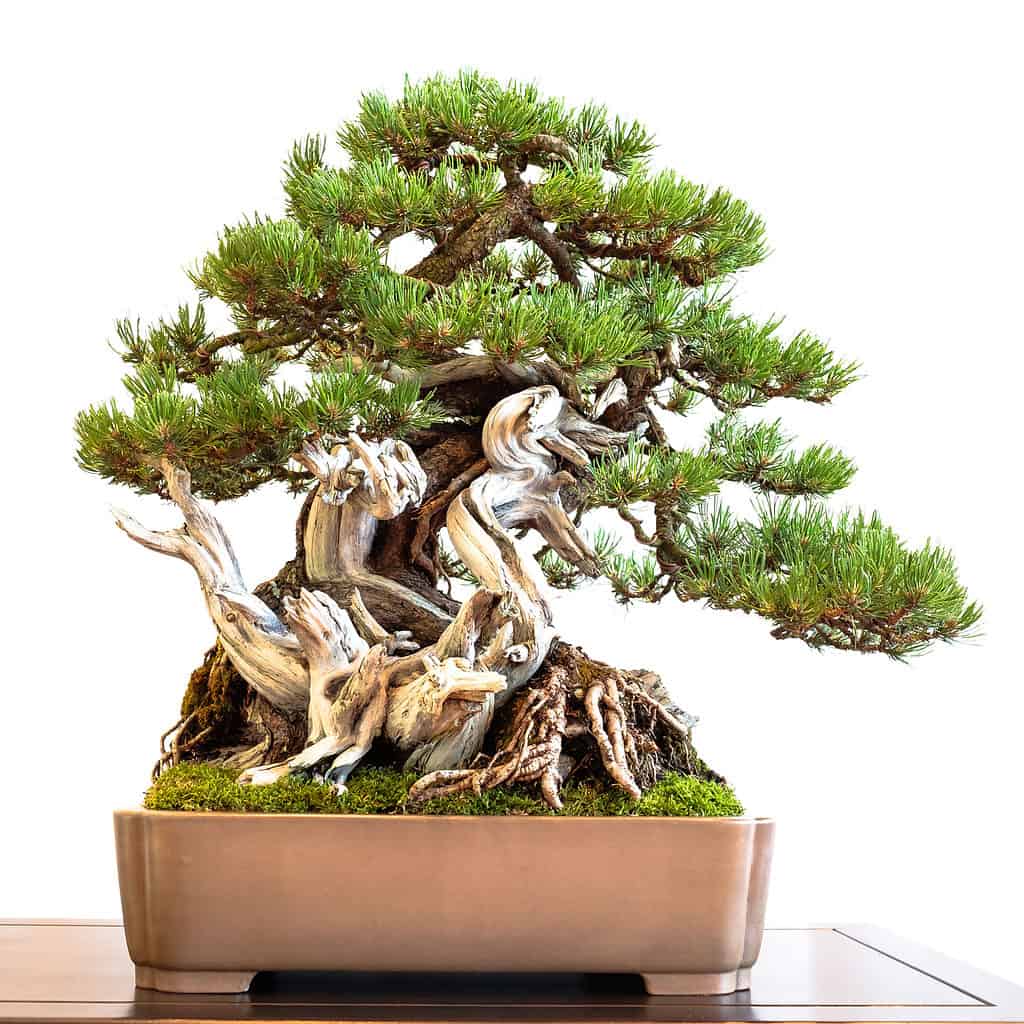
©Bernd Schmidt/Shutterstock.com
Often occurring naturally as a result of elemental damage, deadwood is when the branches of a tree die and get bleached over time by the harsh rays of the sun. For the most part, deadwood happens from wind or ice damage, but you may also notice deadwood occur on trees that have been struck by lightning or burned by forest fires. While fire scars are typically dark in nature, they can still occasionally bleach, though it may take years.
When used in Bonsai tree styling, deadwood helps symbolize the natural struggle that some species of trees experience in their forested environments. It is a beautiful and haunting expression of survival, often bringing plenty of creativity and uniqueness to a Bonsai tree design. Plus, you don’t have to wait years for your deadwood to turn white. There are plenty of tools to accomplish deadwood in a matter of days!
But are there any particular trees best suited to deadwood production? And are there different methods of styling deadwood on a Bonsai tree?
Styles of Bonsai Tree Deadwood
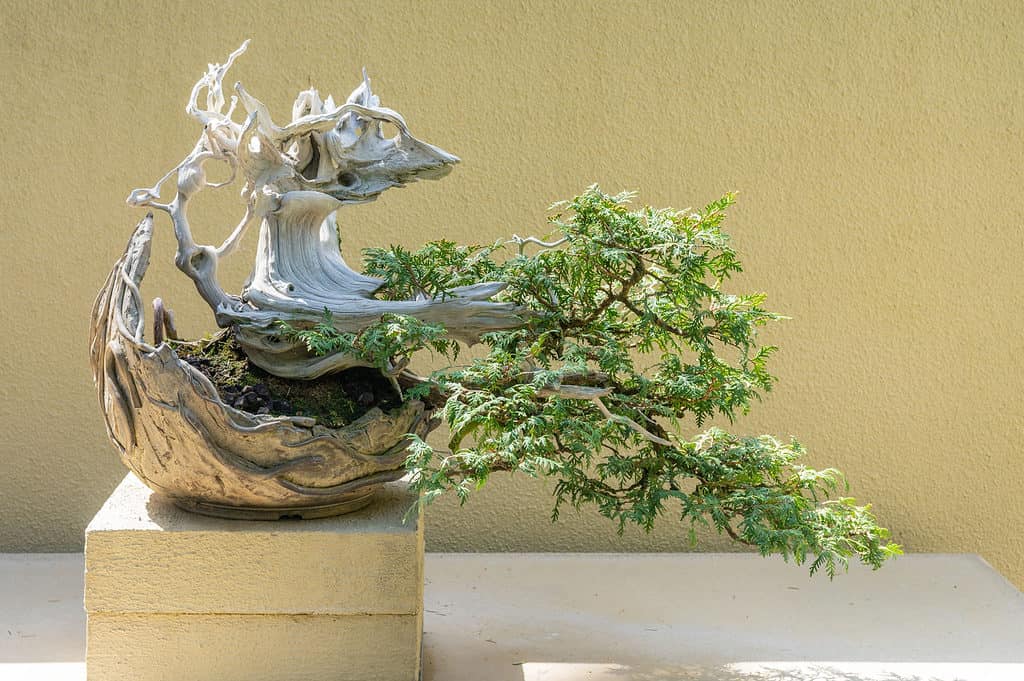
©Mariusz S. Jurgielewicz/Shutterstock.com
Just like all of the different shapes and styles you can use to form your Bonsai tree, there are a few different styles of deadwood to consider as well. Here are the three primary methods of styling your Bonsai tree when crafting deadwood on its branches or trunk.
Jin Deadwood
Often the most common type of deadwood to craft, Jin deadwood refers to a barren and dead branch. On occasion, Jin deadwood happens naturally. If you end up damaging a branch of your Bonsai tree through the invasive process of pruning, you may want to opt for a deadwood branch rather than fully removing the deadened branch.
Jin deadwood is also often the easiest to shape and the best method to start with if you want to experiment with deadwood in your Bonsai tree design. Given the fact that it involves extraneous branches rather than the trunk of your tree, you can always remove Jin deadwood if you don’t like how it turned out or if it appears to harm your tree!
Shari Deadwood
If you have a tree that would benefit from some added interest to its trunk, you may want to consider crafting some Shari deadwood. This process is a bit more involved compared to Jin deadwood, as it means you’ll be gently carving away at the trunk of your tree rather than creating a dead branch.
The most important component to consider when crafting Shari deadwood into your Bonsai tree is the way that nutrients travel up and down the trunk. You don’t want to risk harming your trunk too much, as this could result in weakened or dead branches in the canopy of your tree. Many Bonsai tree artists craft their Shari deadwood with care, often incorporating it into the Nebari or surface root design of their specimen. This is definitely a process for experts!
Uro Deadwood
While the Uro style of deadwood can help create a realistic hollow in any tree species, this is also a method to use with care. To play it safe, you can craft Uro deadwood into your Bonsai tree if you happen to remove any large branches from your central trunk. This is how tree hollows occur naturally, after all: they are a sign of a large branch falling or otherwise getting removed from a tree!
Uro deadwood needs to be done carefully if you are choosing to craft it when there are no large branches to remove. You don’t want to risk cutting off nutrients to your tree, as any trunk deadwood carving promotes this risk. That’s why many artists craft Uro deadwood where a branch used to be. There’s less risk of harming other branches if you create a hollow in an existing wound!
Types of Bonsai Trees for Deadwood Crafting

©Bernd Schmidt/Shutterstock.com
It’s important to note that not all Bonsai tree species can handle deadwood. Many woody shrubs or flowering specimens don’t take well to it, for example. Additionally, certain methods of deadwood crafting are not recommended for certain tree species. That’s why it’s very important to know the type of tree you have and the wood that you’re dealing with, both for the overall strength of the specimen and the healing process.
When crafting Shari or Jin deadwood, it’s important to understand that these methods work best on evergreen trees, particularly conifers. In nature, deadwood typically rots away on deciduous trees. Many fruit or flowering trees will also suffer from deadwood crafting. The point of Bonsai tree artistry is to accurately depict what happens to trees in nature. Shari and Jin deadwood is not traditionally recommended for deciduous trees!
On the other hand, Uro deadwood happens often on all types of trees, particularly deciduous ones. It may be exactly what you need to bring some creative expression to your apple or maple tree without harming it too much or making it look too unrealistic! When done with care, you can technically craft any deadwood into any type of tree. Just keep in mind that you may not be creating a traditional Bonsai tree look or expression.
Here are some common types of Bonsai trees and the deadwood styles that can be crafted into them:
- Juniper (all styles)
- Pine (all styles)
- Cedar (all styles)
- Larch (all styles)
- Fir (all styles)
- Maple (Uro)
- Hawthorn (Shari or Uro)
- Oak (Shari or Uro)
- Beech (Uro)
- Azalea (Shari or Uro)
- Bougainvillea (Uro)
How to Create Deadwood on a Bonsai Tree
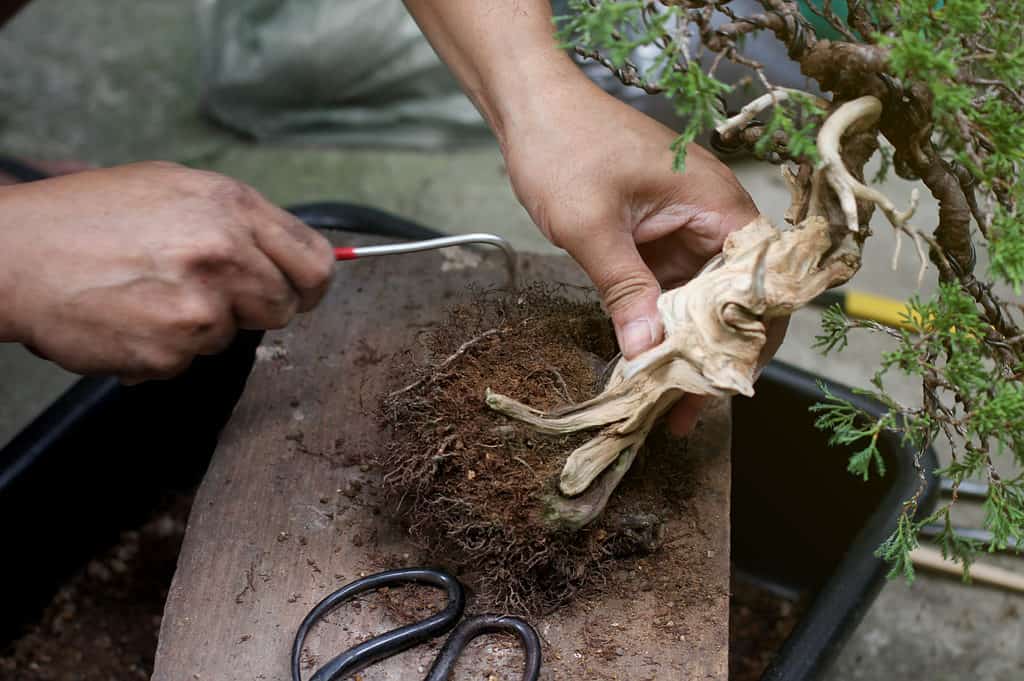
©qSPOoKYp/Shutterstock.com
With practice, care, and the right tools, you can create deadwood in your Bonsai tree! If you have a particular vision or artistic expression in mind for your specimen, here’s how to best accomplish it.
- Gather and sanitize your tools. Bonsai tree tool kits will likely have deadwood carving tools in it, but make sure you at least have some appropriately-sized graving tools and some Jin pliers in order to accomplish barren branches with little damage to the rest of your tree. You may also wish to utilize some concave cutters or shears to carefully prune your tree. Clean all tools in alcohol before getting started!
- Identify the design you want to achieve. Deadwood isn’t something you can simply begin without knowing where you’re going with your design. There’s likely no going back once you start shaping and crafting deadwood. Make sure you have a clear vision of your desired design and shape!
- Carefully begin carving or shaping. If you are crafting Shari or Uro deadwood into the trunk of your tree, utilize a sharp knife and be sure to carve alongside the live veins in your trunk. If you are crafting Jin deadwood, use your Jin pliers to gently strip away at the bark of your branch. You can also twist and turn your deadwood into a desired shape. Most deadwood branches found in nature have distinct whorls and twisted patterns in them as they turn white with age.
Final Steps
- Use sandpaper or other refining tools. If you are satisfied with the overall appearance of your deadwood design, you can use a variety of sanding or smoothing tools to finish your tree. While deadwood occurs slowly in nature, you don’t have to wait! Ensure that your tree is strong enough to handle some refining before finishing your deadwood in style.
- Apply lime sulfur where you have crafted deadwood. Once you have smoothed and completely shaped your deadwood, lime sulfur helps you achieve a finished product. Not only does lime sulfur give your deadwood a bleached appearance, but it also helps seal and protect your tree from rotting or further damage. Gently apply lime sulfur to your Bonsai tree using a paintbrush, taking extra care to cover any deep wounds.
Tips and Tricks for Creating Deadwood
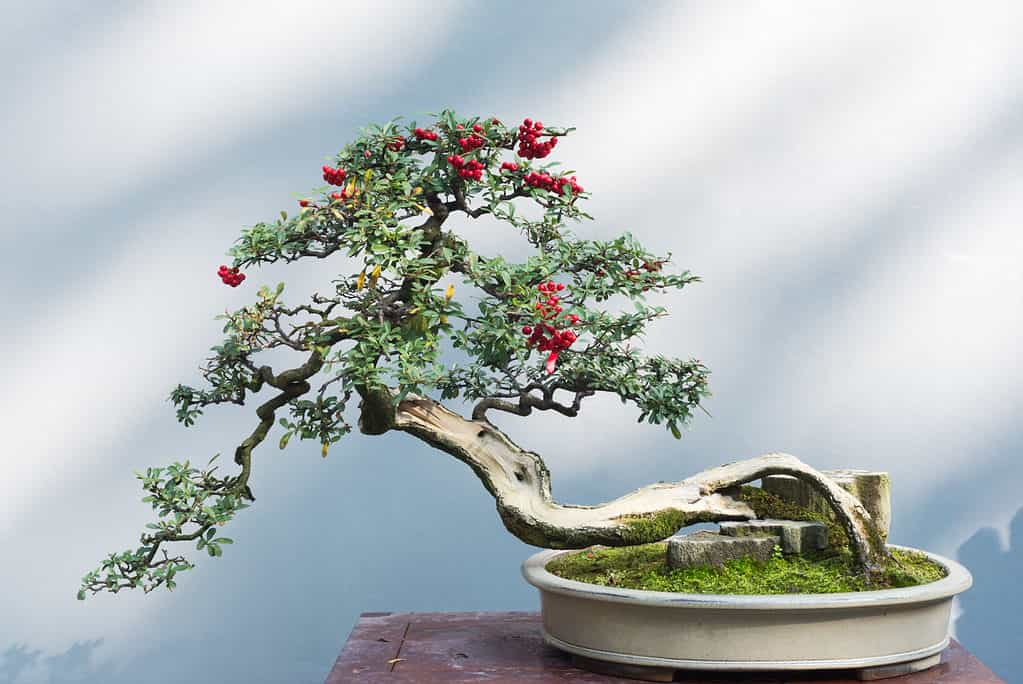
©LP2 Studio/Shutterstock.com
Curious about what else you should keep in mind when crafting deadwood in your Bonsai tree? From seasonal timing to tree species, here are some tips and tricks to think about before starting your deadwood project!
Timing is Everything
No matter what type of Bonsai tree you have, you need to time your deadwood crafting with care. Most Bonsai tree maintenance and styling need to be timed with the seasons as well as any other major work, such as defoliation, pruning, root trimming or styling, and repotting. You should not craft deadwood during the same year as any other intense project! This is the only way to ensure that your Bonsai tree remains healthy and happy for years to come.
Besides taking the time to properly rest your tree, you should also only perform deadwood crafting during growing times of the year. However, this largely differs depending on the type of tree that you have. Most trees grow best during spring and summer, but make sure this is true of your tree as well. By waiting until the growing time of year to craft deadwood, you are better ensuring the health of your tree. It will heal the fastest during these seasons!
Make Sure You Have the Proper Tools
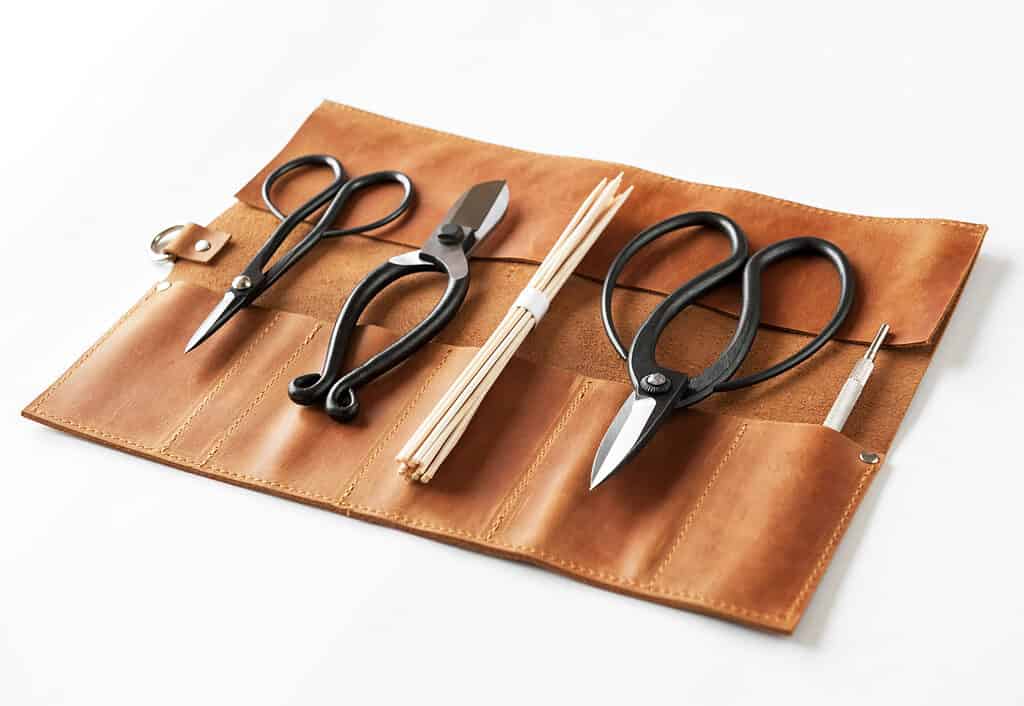
©Olena Antonenko/Shutterstock.com
As previously mentioned, you need the right tools to accomplish Bonsai tree deadwood or any other pruning for that matter. There are many different tool kits and individual shaping tools that you can purchase to craft deadwood, so make sure you do plenty of research on this before getting too excited!
Make Sure Your Species is Good for Deadwood
While you can technically craft deadwood into just about any type of Bonsai tree, your species should inform your design first and foremost. Some trees, such as maples, willows, and jade Bonsai trees, won’t take well to certain types of deadwood. This is largely due to their water retention abilities and the location of your deadwood design. If not done properly, your tree could easily rot from water exposure to the insides of your tree’s trunk or branches!
While achieving a natural look is what Bonsai tree styling is all about, you can always craft deadwood into a tree that wouldn’t normally have deadwood in nature. It’s your tree and your design, after all! Just know that some trees naturally adapt better to deadwood, while others won’t. It all depends on how much you want to fight the natural instincts of your tree.
You Can Always Remove Deadwood Branches!
At the end of the day, any Jin deadwood can be removed from your design. While you likely won’t be able to remove Shari or Uro deadwood from your Bonsai tree without potentially killing it, your Jin deadwood is easily removed. If you craft a deadwood branch and find that it is either harming your tree or detracting from the overall design, simply remove it and try again next year!
While it takes practice, deadwood is a beautiful and unique addition to any Bonsai tree scene. The sky’s the limit in terms of your Bonsai tree creativity– so long as you craft your tree with care!
Up Next:
- The Best Soil for Bonsai Trees
- How to Properly Place a Bonsai Tree
- Bonsai Styles: Everything You Need to Know
The post Bonsai Deadwood: Everything You Need to Know appeared first on AZ Animals.
from Animal News, Facts, Rankings, and More! - AZ Animals https://ift.tt/ZJleIsr